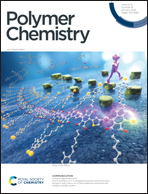Water-soluble macromers based on 2-acrylamido-2-methyl-1-propanesulfonic acid sodium salt (Na-AMPS) for rapid in situ hydrogel film formation†
Abstract
The in situ formation of hydrogels has potential for a number of biomedical applications but their generation via conventional polymerization techniques has a number of limitations, such as toxicity and reaction time. The use of macromers in hydrogel formulations can help overcome these limitations. In this work, we synthesized a new functionalized macromer formed via the copolymerization of 2-acrylamido-2-methylpropane sulfonic acid sodium salt (AMPS) and acid-functional monomers that can undergo a ring-opening reaction with allyl glycidyl ether (AGE) to generate the desired pendant vinyl macromer functionality. These macromers were characterized by 1H nuclear magnetic resonance (NMR) spectroscopy, Fourier transform infrared (FT-IR) spectroscopy and gel permeation chromatography (GPC) to provide evidence for successful macromer synthesis and subsequent polymerization. Using a UV-initiated crosslinking approach with poly(ethylene glycol) diacrylate (PEGDA), the hydrogels were fabricated from the macromer solution, with the gelation time being reduced from 1200 s to 10 s when compared to hydrogel formation from regular vinyl monomers. While different acidic monomers result in distinct tensile properties, hydrogels containing 2-carboxyethyl acrylate (CEA) exhibit low strength but high elongation. In contrast, those with methacrylic acid (MAA) demonstrate higher strength and lower elongation. Therefore, using a balanced combination of each is a logical approach for achieving a robust final hydrogel film. In summary, we have produced a new macromer possessing characteristics highly conducive to rapid hydrogel synthesis. This macromer approach holds potential for use in in situ hydrogel formation, where a viscous solution can be applied to the target area and subsequently hardened to its hydrogel. We envisage its application primarily in the biomedical field.



 Please wait while we load your content...
Please wait while we load your content...